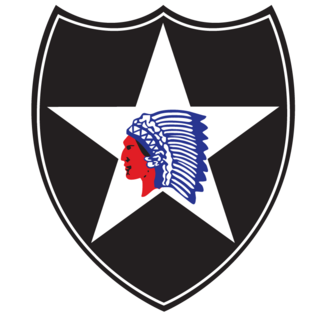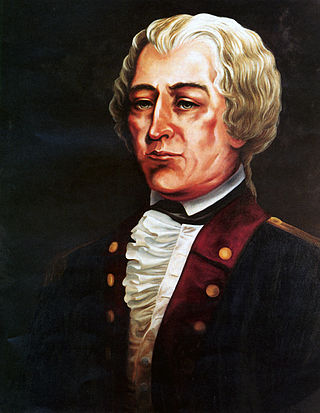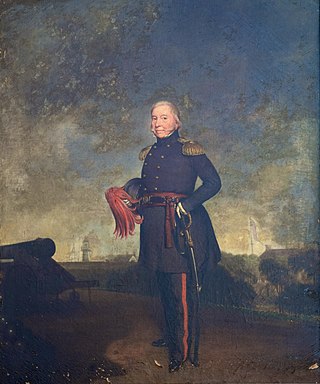
The 2nd Infantry Division ("Indianhead") is a formation of the United States Army. Since the 1960s, its current primary mission is the pre-emptive defense of South Korea in the event of an invasion from North Korea. There are approximately 17,000 soldiers in the 2nd Infantry Division, with 10,000 of them stationed in South Korea, accounting for about 35% of the United States Forces Korea personnel. Denoted the 2nd Infantry Division-ROK/U.S. Combined Division (2ID/RUCD), the division is augmented by rotational Brigade Combat Teams (BCTs) from other U.S. Army divisions.

The 9th Infantry Division is an inactive infantry division of the United States Army. It was formed as the 9th Division during World War I, but never deployed overseas. In later years it was an important unit of the U.S. Army during World War II and the Vietnam War. It was also activated as a peacetime readiness unit from 1947 to 1962 at Fort Dix, New Jersey, and Fort Carson, Colorado, and from 1972 to 1991 as an active-duty infantry division at Fort Lewis, Washington. The division was inactivated in December 1991.

Henry Burbeck was a senior officer of the United States Army who served as the Commandant of the Corps of Artillerists and Engineers from 1798 to 1802.

John Doughty was an American military officer who briefly served as the senior officer of the United States Army in 1784. Holding the rank of major at the time, he bears the distinction of being the lowest ranked individual ever to serve as the senior most United States Army officer.

During the American Revolutionary War, the New York Provincial Company of Artillery was created by the New York Provincial Congress in 1776 to defend New York City from British attack.

The 4th Air Defense Artillery Regiment was constituted 1 June 1821 in the Regular Army as the 4th Regiment of Artillery and organized from new and existing units with headquarters at Pensacola, Florida. As a result of the division of the Artillery Corps into Coast and Field Artillery units, the Regiment was broken up 13 February 1901, and its elements reorganized and redesignated as separate numbered companies and batteries of the Artillery Corps.
1st American Regiment, also known as Jackson's Continental Regiment of 1783–1784, was the last unit in the Continental Army, retained after the close of the American Revolutionary War. This regiment, under the command of Colonel Henry Jackson of Massachusetts, was not the same unit as Jackson's Additional Continental Regiment of 1777, which had become the 16th Massachusetts Regiment in 1780 and had been disbanded in 1781. Equally, this regiment should not be confused with the First American Regiment of 1784–1791, which was originally commanded by Colonel Josiah Harmar, has remained in service to the present, and is now the 3d United States Infantry Regiment.

The 5th Field Artillery Regiment was constituted as part of the Regular Army in January 1907. Individual battalions have lineages which date back further. Currently, it is a parent regiment under the U.S. Army Regimental System, with a single active battalion, the 1st Battalion, 5th Field Artillery, which is assigned to the 1st Brigade Combat Team, 1st Infantry Division at Fort Riley, Kansas.

John Baptiste de Barth Walbach was an Alsatian baron who fought in the French Revolutionary Wars, and was one of the few foreign-born senior officers in the United States Army prior to the American Civil War, attaining the rank of brevet brigadier general.

The 2nd Battalion, 1st Air Defense Artillery Regiment is a battalion in the 1st Air Defense Artillery Regiment, a regiment in the United States Army, first formed in 1812, and based in South Korea.

The 2nd Air Defense Artillery Regiment is an air defense artillery regiment of the United States Army, first formed in 1821 as a field artillery unit.

The 6th Field Artillery Regiment is a Field Artillery Branch regiment of the United States Army first activated in 1907 from numbered companies of artillery. It was first organized with two battalions.
Twenty-four current units of the Army National Guard perpetuate the lineages of militia units mustered into federal service during the War of 1812. Militia units from nine states that were part of the Union by the end of the War of 1812, plus the District of Columbia, are the predecessors of eighteen units that currently exist in the Army National Guard. Two of the four units derived from Virginia militias are in the West Virginia National Guard; at the time of the War of 1812, West Virginia was still part of Virginia. Only two current units, the 155th Infantry, a component of the Mississippi National Guard derived from militia units organized in the Mississippi Territory and the 130th Infantry, a component of the Illinois National Guard derived from militia units formed in the Illinois Territory, are from states or territories west of the Appalachians. Unfortunately, no militia units from the states of Kentucky, Louisiana, Ohio or Tennessee, or from the Indiana, Michigan, Missouri or Louisiana Territories, where militia units played a major role in the fighting, have survived as units in the modern Army National Guard.
Twenty-three currently active battalions of the Regular Army earned credit for campaigns during the War of 1812: two Air Defense Artillery battalions, six Field Artillery Battalions and seventeen Infantry battalions. These twenty-three battalions represent two Air Defense Artillery, four Field Artillery and seven Infantry regiments. Three additional Air Defense Artillery regiments have been awarded shared credit for War of 1812 campaigns, but the lineages of the artillery companies that earned those credits have not been perpetuated by currently active battalions.

The 103rd Field Artillery Regiment is a regiment of the United States Army. The only currently existing component is the 1st Battalion, 103rd Field Artillery Regiment, a unit of the Rhode Island National Guard. The regiment was originally constituted in 1917, but it descends from predecessor units dating back to 1801.

The 2nd Battalion, 3rd Field Artillery Regiment is an artillery unit of the United States Army. The battalion traces its lineage to 1812, and it is currently assigned to the 1st Brigade Combat Team, 1st Armored Division. The battalion has served in the Seminole Wars, the Civil War, the Spanish–American War, World War I, World War II, Operations Desert Shield and Desert Storm, Operation Iraqi Freedom, and Operation Enduring Freedom.
The Militia and Volunteers of County Durham are those military units raised in the County independent of the regular Army. The "modern" militia dates from legislation enacted during the Seven Years' War. The volunteers had several forms and separate periods of existence until made a permanent body in 1859.

The 429th Brigade Support Battalion is a combat service support battalion of the United States Army and the Virginia National Guard. It is part of the 116th Infantry Brigade Combat Team, Virginia Army National Guard.
Moses Porter was a general in the United States Army during the War of 1812. His career lasted for over 40 years and he is one of the few officers who served in both the American Revolution and the War of 1812.













